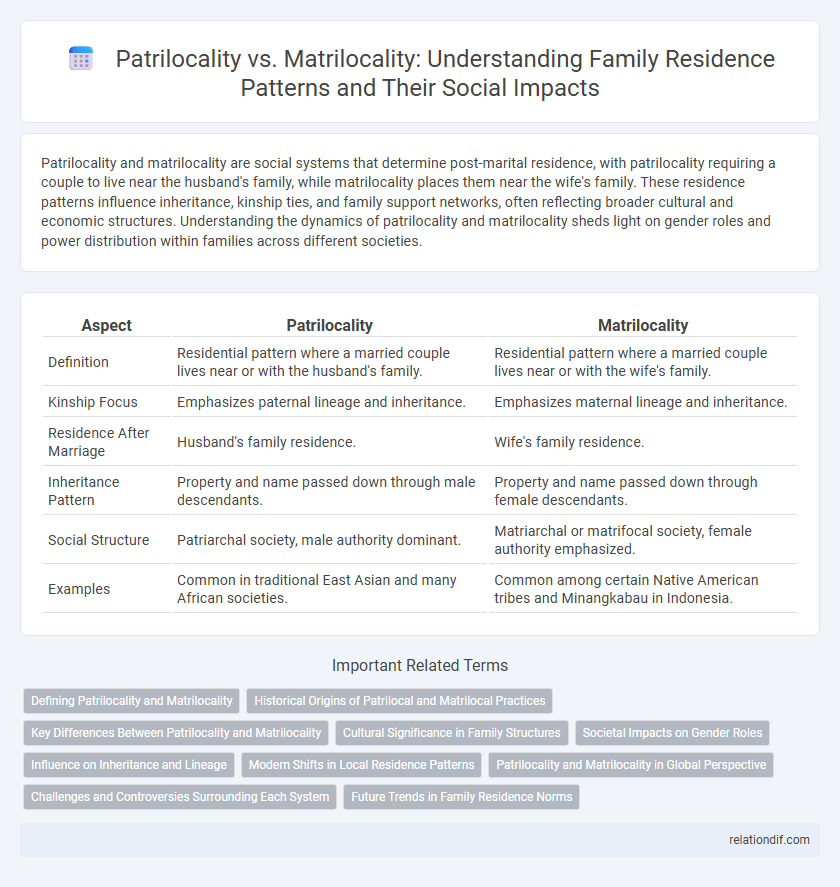Patrilocality and matrilocality are social systems that determine post-marital residence, with patrilocality requiring a couple to live near the husband's family, while matrilocality places them near the wife's family. These residence patterns influence inheritance, kinship ties, and family support networks, often reflecting broader cultural and economic structures. Understanding the dynamics of patrilocality and matrilocality sheds light on gender roles and power distribution within families across different societies.
Table of Comparison
| Aspect | Patrilocality | Matrilocality |
|---|---|---|
| Definition | Residential pattern where a married couple lives near or with the husband's family. | Residential pattern where a married couple lives near or with the wife's family. |
| Kinship Focus | Emphasizes paternal lineage and inheritance. | Emphasizes maternal lineage and inheritance. |
| Residence After Marriage | Husband's family residence. | Wife's family residence. |
| Inheritance Pattern | Property and name passed down through male descendants. | Property and name passed down through female descendants. |
| Social Structure | Patriarchal society, male authority dominant. | Matriarchal or matrifocal society, female authority emphasized. |
| Examples | Common in traditional East Asian and many African societies. | Common among certain Native American tribes and Minangkabau in Indonesia. |
Defining Patrilocality and Matrilocality
Patrilocality refers to a social system where a married couple resides near or with the husband's family, emphasizing lineage and inheritance through the male line. Matrilocality, conversely, is a residence pattern in which a married couple lives near or with the wife's family, highlighting maternal kinship ties and inheritance. These residence patterns significantly influence family structure, inheritance practices, and social dynamics within various cultures.
Historical Origins of Patrilocal and Matrilocal Practices
Patrilocality and matrilocality trace back to ancient kinship systems where social organization centered around either male or female lineage, shaping residence patterns post-marriage. Historically, patrilocality emerged predominantly in agrarian societies emphasizing male control over land and resources, reinforcing patriarchal structures. Matrilocality, less common, was often found in societies valuing maternal lineage for inheritance and social cohesion, such as some Indigenous and matrilineal cultures.
Key Differences Between Patrilocality and Matrilocality
Patrilocality refers to a social system where a married couple resides near or with the husband's family, emphasizing male lineage and inheritance, whereas matrilocality centers on living near or with the wife's family, highlighting female lineage and kinship ties. Key differences include residence patterns after marriage, inheritance laws, and family authority structures, with patrilocal societies often prioritizing patriarchal authority and matrilocal societies granting more influence to maternal relatives. These distinctions impact social organization, resource distribution, and cultural traditions in different societies.
Cultural Significance in Family Structures
Patrilocality and matrilocality significantly influence family structures by determining residence patterns after marriage, shaping kinship bonds and inheritance customs. In patrilocal societies, cultural traditions emphasize male lineage and property transmission through the father's family, strengthening paternal authority and community ties. Conversely, matrilocal arrangements highlight female lineage, fostering maternal kin networks and often granting women greater social influence within the family and local community.
Societal Impacts on Gender Roles
Patrilocality tends to reinforce traditional gender roles by emphasizing male authority and inheritance within the household, often limiting women's social mobility and decision-making power. In contrast, matrilocality can empower women by centering family residence around the wife's kin group, fostering stronger female networks and shared responsibilities. These residence patterns significantly shape societal expectations, influencing gender dynamics, inheritance systems, and access to resources within communities.
Influence on Inheritance and Lineage
Patrilocality directs inheritance and lineage through the male line, reinforcing paternal property rights and family name continuity, often concentrating wealth and social status within the husband's kin group. Matrilocality shifts inheritance patterns toward the female lineage, emphasizing maternal family ties and sometimes allowing for more equitable distribution of resources among relatives. These residence patterns deeply shape the transmission of cultural identity and economic assets across generations.
Modern Shifts in Local Residence Patterns
Modern shifts in local residence patterns show a gradual move away from traditional patrilocality, where couples live near the husband's family, toward more matrilocal or neolocal arrangements. Urbanization, increased female workforce participation, and changing gender roles contribute to these evolving residential preferences. This shift reflects broader social transformations affecting family dynamics and inheritance practices.
Patrilocality and Matrilocality in Global Perspective
Patrilocality, where a married couple resides near the husband's family, predominates in many regions of Asia, Africa, and the Middle East, reflecting patriarchal social structures and inheritance patterns. Matrilocality, more common in parts of Southeast Asia, indigenous North America, and some African communities, situates the couple near the wife's family, often reinforcing matrilineal descent and female kinship ties. Global trends show patrilocality's dominance aligning with agricultural and pastoral economies, while matrilocality tends to persist in societies with strong clan-based or matrilineal traditions.
Challenges and Controversies Surrounding Each System
Patrilocality often faces challenges related to gender inequality and reduced autonomy for women, as brides typically relocate to their husband's family, potentially leading to cultural alienation and limited support networks. Matrilocality can generate conflicts over inheritance and property rights, especially in patriarchal societies where lineage and resources are traditionally traced through males. Both systems provoke controversies surrounding power dynamics, family cohesion, and the social integration of spouses, highlighting the deep cultural and economic implications of residential patterns after marriage.
Future Trends in Family Residence Norms
Future trends in family residence norms are shifting towards more flexible arrangements, blending patrilocality and matrilocality with neolocal residence patterns. Increasing gender equality and urbanization contribute to couples choosing residences based on economic opportunities rather than traditional lineage ties. Technology and changing social values support diverse family structures, further diminishing strict patrilocal or matrilocal norms in favor of adaptable living arrangements.
Patrilocality vs Matrilocality Infographic

 relationdif.com
relationdif.com